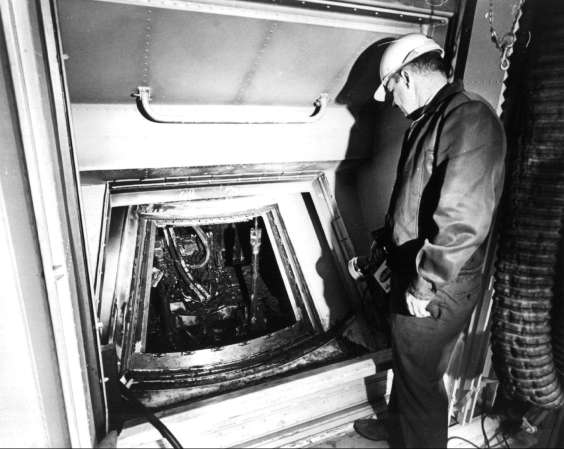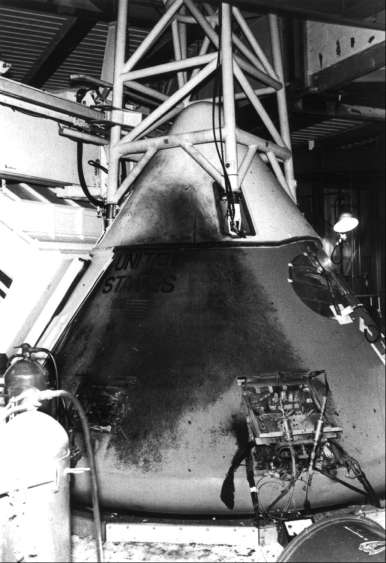
Disaster at Pad 34
While top administrators were checking out the fears of Tom Baron, two NASA men, Clarence Chauvin and R. E. Reyes, and two North American Project Engineers, Bruce Haight and Chuck Hannon, met on the morning of 26 January at launch complex 34 to review the general spacecraft readiness and configuration for one of the last major previews, the plugs-out test. The craft looked ready.37
That same night the prime and backup crews studied mission plans. The next day a simulated countdown would start shortly before liftoff and then the test would carry through several hours of flight time. There would be no fuel in the Saturn. Grissom, White, and Chaffee would don their full spacesuits and enter the Apollo, breathing pure oxygen to approximate orbital conditions as closely as possible. After simulated liftoff, the spacecraft center in Houston would monitor the performance of the astronauts. The plugs-out test did not rate a hazardous classification; the spacecraft had successfully operated in the test chamber for a greater period of time than it would on the pad.38
The astronauts entered the Apollo at 1:00 p.m., Friday, 27 January 1967. Problems immediately arose. NASA Spacecraft Test Conductor Clarence Chauvin later described them: "The first problem that we encountered was when Gus Grissom ingressed into the spacecraft and hooked up to his oxygen supply from the spacecraft. Essentially, his first words were that there was a strange odor in the suit loop. He described it as a 'sour smell' somewhat like buttermilk." The crew stopped to take a sample of the suit loop, and after discussion with Grissom decided to continue the test.
The next problem was a high oxygen flow indication which periodically triggered the master alarm. The men discussed this matter with environmental control systems personnel, who believed the high flow resulted from movements of the crew. The matter was not really resolved.
A third serious problem arose in communications. At first, faulty communications seemed to exist solely between Command Pilot Grissom and the control room. The crew made adjustments. Later, the difficulty extended to include communications between the operations and checkout building and the blockhouse at complex 34. "The overall communications problem was so bad at times," Chauvin testified, "that we could not even understand what the crew was saying."39 William H. Schick, Assistant Test Supervisor in the blockhouse at complex 34, reported in at 4:30 p.m. and monitored the spacecraft checkout procedure for the Deputy of Launch Operations. He sat at the test supervisor's console and logged the events, including various problems in communications.40 To complicate matters further, no one person controlled the trouble-shooting of the communications problem.41 This failure in communication forced a hold of the countdown at 5:40 p.m. By 6:31 the test conductors were about ready to pick up the count when ground instruments showed an unexplained rise in the oxygen flow into the spacesuits. One of the crew, presumably Grissom, moved slightly.
Four seconds later, an astronaut, probably Chaffee, announced almost casually over the intercom: "Fire. I smell fire." Two seconds later, Astronaut White's voice was more insistent: "Fire in the cockpit."
In the blockhouse, engineers and technicians looked up from their consoles to the television monitors trained at the spacecraft. To their horror, they saw flames licking furiously inside Apollo, and smoke blurred their pictures. Men who had gone through Mercury and Gemini tests and launches without a major hitch stood momentarily stunned at the turn of events. Their eyes saw what was happening, but their minds refused to believe. Finally a near hysterical shout filled the air: "There's a fire in the spacecraft!"
Procedures for emergency escape called for a minimum of 90 seconds. But in practice the crew had never accomplished the routines in the minimum time. Grissom had to lower White's headrest so White could reach above and behind his left shoulder to actuate a ratchet-type device that would release the first of a series of latches. According to one source, White had actually made part of a full turn with the ratchet before he was overcome by smoke. In the meantime, Chaffee had carried out his duties by switching the power and then turning up the cabin lights as an aid to vision. Outside the white room that totally surrounded the spacecraft, Donald O. Babbitt of North American Aviation ordered emergency procedures to rescue the astronauts. Technicians started toward the white room. Then the command module ruptured.42
Witnesses differed as to how fast everything happened. Gary W. Propst, an RCA technician at the communication control racks in area D on the first floor at launch complex 34, testified four days later that three minutes elapsed between the first shout of "Fire" and the filling of the white room with smoke. Other observers had gathered around his monitor and discussed why the astronauts did not blow the hatch and why no one entered the white room. One of these men, A. R. Caswell, testified on 2 February, two days after Propst. In answer to a question about the time between the first sign of fire and activity outside the spacecraft in the white room, he said: "It appeared to be quite a long period of time, perhaps three or four minutes. . . ."43
The men on the launch tower told a different story. Bruce W. Davis, a systems technician with North American Aviation who was on level A8 of the service structure at the time of the fire, reported an almost instantaneous spread of the fire from the moment of first warning. "I heard someone say, 'There is a fire in the cockpit.' I turned around and after about one second I saw flames within the two open access panels in the command module near the umbilical." Jessie L. Owens, North American Systems Engineer, stood near the pad leader's desk when someone shouted: "Fire." He heard what sounded like the cabin relief valve opening and high velocity gas escaping. "Immediately this gas burst into flames somewhat like lighting an acetylene torch," he said. "I turned to go to the white room at the above-noted instant, but was met by a flame wall."44
Spacecraft technicians ran toward the sealed Apollo, but before they could reach it, the command module ruptured. Flame and thick black clouds of smoke billowed out, filling the room. Now a new danger arose. Many feared that the fire might set off the launch escape system atop Apollo. This, in turn, could ignite the entire service structure. Instinct told the men to get out while they could. Many did so, but others tried to rescue the astronauts.
Approximately 90 seconds after the first report of fire, pad leader Donald Babbitt reported over a headset from the swing arm that his men had begun attempts to open the hatch. Thus the panel that investigated the fire concluded that only one minute elapsed between the first warning of the fire and the rescue attempt. Babbitt's personal recollection of his reporting over the headset did not make it clear that he had already been in the white room, as the panel seemed to conclude.45 Be that as it may, for more than five minutes, Babbitt and his North American Aviation crew of James D. Gleaves, Jerry W. Hawkins, Steven B. Clemmons, and L. D. Reece, and NASA's Henry H. Rodgers, Jr., struggled to open the hatch. The intense heat and dense smoke drove one after another back, but finally they succeeded. Unfortunately, it was too late. The astronauts were dead. Firemen arrived within three minutes of the hatch opening, doctors soon thereafter. A medical board was to determine that the astronauts died of carbon monoxide asphyxia, with thermal burns as contributing causes. The board could not say how much of the burns came after the three had died. Fire had destroyed 70% of Grissom's spacesuit, 25% of White's, and 15% of Chaffee's.46 Doctors treated 27 men for smoke inhalation. Two were hospitalized.
Rumors of disaster spread in driblets through the area. Men who had worked on the day shift returned to see if they could be of help. Crewmen removed the three charred bodies well after midnight.47

The interior of the AS-204 spacecraft after the fire: Dale Carothers, Spacecraft Operations Directorate, in the white room, looking through the open hatch.

Exterior of AS-204, with the white room to the left.
The sudden deaths of the three astronauts caused international grief and widespread questioning of the space program. Momentarily the whole manned lunar program stood in suspense. Writing in Newsweek, Walter Lippman immediately deplored what he called the pride-spurred rush of the program.48 The Washington Sunday Star spoke of soaring costs and claimed that "know-who" had more to do than "know-how" in the choice of North American over Martin Marietta as prime contractor for the spacecraft.49 A long-time critic of the space program, Senator William J. Fulbright of Arkansas, Chairman of the Senate Foreign Relations Committee, placed the "root cause of the tragedy" in "the inflexible, but meaningless, goal of putting an American on the moon by 1970" and called for a "full reappraisal of the space program." The distinguished scientist Dr. James A. Van Allen, discoverer of radiation belts in space, charged that NASA was "losing its soul." It had become "a huge engineering, technological and operational agency with less and less devotion to the true spirit of exploration and to the advancement of basic knowledge."50 A lead editorial in the New York Times spoke of the incompetence and negligence that became apparent as the full story of disaster came to light, but put the central blame on "the technically senseless" and "highly dangerous" dedication to the meaningless timetable of putting a man on the moon by 1970.51 An article in the American Institute of Chemical Engineers Journal had the long-anticipated title: "NASA's in the Cold, Cold Ground."52 But President Johnson held firm to the predetermined goal and communicated his confidence to NASA.53
| Next |